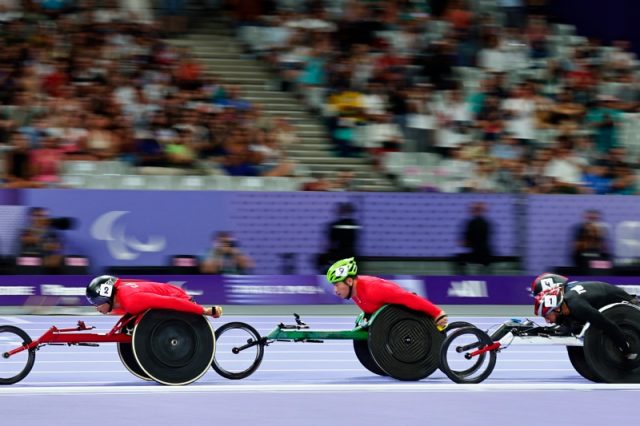
The Paris Olympics have been and gone but memories of the athletes’ achievements will live on, from Mondo Duplantis breaking his own pole vault world record for the ninth time, to Sifan Hassan winning gold in women’s marathon after winning bronze in the 5,000 and 10,000m on the track earlier in the games.
For many viewers, performances like this inspire us to achieve more and strive for better.
Now, we have another opportunity for inspiration through the Paralympic Games.
Getting started
The genesis of the Paralympic Games came after the second world war, when Ludwig Guttman founded a spinal injuries center at the Stoke Mandeville Hospital in Great Britain.
The rehabilitative power of sport led to the development of the Stoke Mandeville Games in 1948 when 16 injured servicemen and women competed in archery.
Following the growth of these games, the Paralympic Games were first held in Rome in 1960 with 400 athletes from 23 countries.
In 1976, the Paralympic Winter Games were introduced, and while the summer and winter games were held every four years, they were not aligned with the host cities for the Olympic Games.
Since 1988 (Seoul, Korea), the Paralympics and Olympics have taken part in the same cities following agreement from the International Olympic Committee and the International Paralympic Committee.
Incredible athletes
Some of the feats achieved by para athletes are truly remarkable.
George Eyser was a US gymnast and Olympian at the 1904 Olympic Games in St Louis, Missouri.
Eyser won six medals (three gold) within the space of one day. The fact Eyser achieved this success with a prosthetic leg sets him apart.
Eyser though is not the only athlete with a disability to achieve incredible feats and he is not the only athlete with a disability to compete at the Olympic Games.
Australian table tennis player Melissa Tapper is the first Australian athlete to qualify for the Olympic and Paralympic teams.
Tapper has competed at three Olympic Games (2016-2024) and four Paralympic Games (2012-2024), winning a silver medal in the class 9-10 women’s event at Rio in 2016.
In para-cycling, athletes with physical disabilities compete across three different disciplines (bicycling, tricycling and hand cycling) and are classified into one of five classes (C1-C5).
Athletes across these classes reach impressive speeds on the track that near those of athletes without a disability.
In the C1 class (for athletes with the greatest degree of impairment) athletes average speeds approximately 75% of non-disabled cyclists while the C5 class reached 90% during the 1km time trial on the track.
On the athletics track, it’s hard to go past the performances of Madison de Rozario, who will compete at her fifth Paralympic Games in Paris.
With six medals (two gold, three silver, one bronze) leading into Paris, de Rozario has already added a bronze medal in the 5000m T54 class to her tally.
While many people can tell you that US swimmer Michael Phelps won 23 gold medals, three silver, and two bronze, he is still a whopping 27 medals behind the greatest Paralympian of all time. US swimmer Trischa Zorn competed at seven Paralympic Games (1980 – 2004) and won 55 medals.
Not only did Zorn win a phenomenal number of medals, 41 of them were gold (12 in Seoul 1988). Remarkably, more than 60% of the top ten most decorated gold medallists at the Summer Paralympic Games are para swimmers.
The Paralympics are a chance for us to celebrate the diversity and success of athletes with disabilities.
In many cases, the performances of these athletes meet or exceed those of their Olympic counterparts.
This is especially true on the athletics track, where wheelchair world records are faster than Olympic records for every distance greater than 400m.
For power sports, look no further than the para-powerlifting, where athletes with disabilities would hold almost all bench press world records.
Unique events
Performance comparisons are usually possible because most Paralympic sports are also contested at the Olympic Games.
However, some sports, such as goalball and boccia are exclusive to the Paralympic Games.
Boccia, in particular, is notable for its inclusivity, as it caters to athletes with severe impairments who are often underrepresented in para sport.
Boccia athletes are classified into four sport classes — BC1 to BC4 — and compete in singles, pairs, and team events. Their goal is to throw, kick or roll a set number of balls of varying hardness and texture as close as possible to a target white ball, known as the “jack,” using their arms, legs, or a ramp device (for BC3 athletes).
Australia has yet to claim a gold medal in Boccia, but there is hope on the horizon, with Dan Michel and Jamieson Leeson poised to make history for the country in this sport.
So, as we watch these fantastic athletes in Paris, let’s remember, the Paralympic Games are not a sideshow or a follow-up to the Olympics – they are a world class, high-performance experience to be celebrated in their own right.![]()
Dan van den Hoek, Senior Lecturer, Clinical Exercise Physiology, University of the Sunshine Coast and Angelo Macaro, Researcher and Administrator, The University of Queensland. This article is republished from The Conversation under a Creative Commons license. Read the original article.









